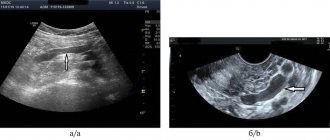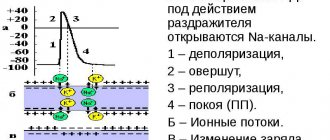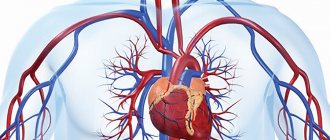Somatoform dysfunction of the autonomic nervous system is a disease accompanied by signs of dysfunction of internal organs.
However, numerous examinations reject the presence of organic pathology: the condition is due to a psychogenic nature. Often the concept is replaced by the terms vegetative-vascular dystonia or neurocirculatory dystonia, which are not included in the official international medical classification. ICD-10 classifies somatoform dysfunction as a neurotic disorder, defining it with code F 45.3.
Causes of autonomic dystonia syndrome
Autonomic dystonia syndrome is classified as a consequence of various pathologies of the central and peripheral nervous system. VDS is not an independent disease and rarely occurs overnight. The causes of vegetative dystonia syndrome are as follows:
- Problems at home, at school, which lead to systematic constant stress;
- Brain damage due to problems during pregnancy;
- Hormonal changes in adolescence (adolescence);
- Heredity, expressed by poor tolerance to work, high meteotropicity, and so on;
- Diseases of the endocrine system (diabetes mellitus, etc.);
- Bronchial asthma, stomach ulcer, hypertension and other somatic pathologies;
- Passive lifestyle;
- Systematic diseases of the nervous system;
- Carious teeth, sinusitis, otitis media and other permanent foci of infection;
- Mental and physical overload;
- Persistent autoimmune diseases.
Formation mechanism
The autonomic nervous system is the main regulator of the activity of internal organs, blood vessels and glands. Therefore, this system is often called visceral. The ANS regulates the functioning of organs in accordance with changes in environmental conditions.
The autonomic system is represented by two departments: sympathetic and parasympathetic, which have mutually opposite effects:
- The sympathetic nervous system mobilizes the body's defense reactions, preparing it for vigorous activity. Intensifies metabolism, increases arousal;
- The parasympathetic nervous system restores wasted energy. Stabilizes the body's condition. Supports its work during sleep.
Both departments have opposite effects on internal organs.
| Organ | Sympathetic NS | Parasympathetic NS |
| Heart | Tachycardia, increased force of contractions | Bradycardia, decreased force of contractions |
| Arteries | Constriction of organs, dilation of muscle vessels | Dilates blood vessels of the genitals and brain; narrows the coronary and pulmonary arteries. |
| Intestines | Inhibits peristalsis and enzyme synthesis | Enhances peristalsis and enzyme synthesis |
| Pulmonary system | Bronchial dilatation, hyperventilation of the lungs | Narrowing of the bronchi, decreased ventilation |
| Bladder | Relaxation | Reduction |
| Salivary glands | Depresses work | Stimulates saliva secretion |
| Pupil | Expands | Narrows |
The opposite influence of systems with balanced work helps to balance the condition of the internal organs. The ANS is not subject to human will. For example, we cannot make the heart stop beating. But vegetative activity is subject to the influence of stress factors. This is easy to check. Remember how your heart begins to “rumble” when you are scared. The mouth becomes dry, intestinal colic appears, and the urge to urinate increases. This activates the sympathetic department, mobilizing the body's protective resources.
The fear went away - the heart calmed down, breathing returned to normal. This is the merit of parasympathetics.
Problems begin when the activities of both departments are separated. There are several reasons for this imbalance:
- heredity;
- hormonal changes;
- chronic stress;
- powerful simultaneous stress impact;
- overwork;
- chronic intoxication;
- alcohol abuse;
- radiation;
- action of high temperatures.
Disharmony in the activity of the ANS triggers the formation of somatoform dysfunction of the autonomic nervous system. Vegetative control over organs decreases. Their work is disrupted, giving rise to painful symptoms, but there are no organic changes. The main reason is stress.
Somatic symptoms are a way of experiencing stressful situations at a physiological level. This was also discussed by Adler, who developed the concept of the symbolic language of organs. The theory said: organ systems specifically mirror mental processes.
What is the manifestation of vegetative dystonia syndrome?
Autonomic dystonia syndrome is divided into three main types:
Vegetative-vascular-trophic syndrome is based on autonomic disorders caused by lesions of mixed nerves, roots and plexuses responsible for supplying impulses to the extremities.
The syndrome of progressive autonomic failure is expressed by peripheral and cerebral disorders in combination with peripheral segmental disorders.
Psychovegetative syndrome is manifested by paroxysmal disorders caused by dysfunction of various brain systems.
Neurocirculatory dystonia or VSD?
When it comes to the types of autonomic disorders, it is customary to use the classification of V.I. Makolkin, who once substantiated the concept of a violation of vascular regulation and called it neurocirculatory dystonia (NCD). In accordance with this classification, there are:
- NCD of the hypertensive type,
- NCD of hypotonic type,
- NDC of mixed type.
Subsequently, NCD became synonymous with VSD, and doctors used this classification for diagnosis and treatment for a long time.
Dystonia of the mixed type is manifested by unstable vascular tone, when blood pressure can spontaneously increase or decrease, and is also accompanied by various vegetative symptoms. Characteristic of the mixed type of vascular disorders is a rapid change in symptoms of high and low blood pressure. For example, after redness and a feeling of heat, weakness, pallor and chills (similar to hot flashes during menopause) may suddenly occur, and pulsation in the head may give way to dizziness and fainting. All this is usually triggered by stress.
But this approach is focused on disorders of the autonomic regulation of blood vessels and does not take into account many other symptoms that certainly exist in all types of dystonia.
Symptoms of autonomic dystonia syndrome
Symptoms of SVD directly depend on which system or organ is affected. The disease leads to dysfunction of body systems. According to the nature of the course in children, the following deviations are distinguished:
Vagotonia is a disorder of the nervous system, which is manifested by acrocyanosis of the feet and hands. This pathology is manifested by blueness of the extremities. The reason for this is the extremely slow flow of blood to the extremities through small vessels. Other symptoms of SVD include acne, hyperhidrosis, as well as allergies and swelling under the eyes. In the case of a depressive disorder of the nervous system, the skin becomes cold, dry and quite pale, the vascular network becomes unexpressed. In some cases, an eczematous rash and itching may be noticed.
A characteristic disorder is a clear violation of thermoregulation: poor tolerance of frost, wet weather, drafts, as well as constant chills and chilliness.
Children with vegetative dystonia syndrome often complain of poor functioning of the gastrointestinal tract. Nausea, abdominal pain, vomiting, heartburn, diarrhea or, conversely, prolonged constipation, pain behind the sternum, a lump in the throat - a common occurrence with SVD. The cause of these disorders is contraction of the muscles of the esophagus and pharynx. Depending on the age of the child, the most popular symptoms of vegetative dystonia syndrome are: pain in the abdominal area - 6-12 years; periodic vomiting – 3-8 years; diarrhea and constipation – 1-3 years; colic and regurgitation - up to 1 year.
SVD is most clearly represented by dysfunction of the cardiovascular system. This condition is called neurocirculatory dystonia. With this disease, there can be a huge number of cardiac dysfunctions, the most popular of which are associated with conduction and heart rhythm disturbances. Traditionally, cardiac dysfunction includes:
Extrasystole is a contraction of the heart before the set time. Among all arrhythmias, children's extrasystole is a noticeable leader: about 75% of cases are due to this particular disorder. With extrasystole, patients complain of headache, irritability, dizziness, excessive fatigue, and so on. In parallel with this, other diseases and abnormalities arise: high meteotropicity, weather dependence, as well as vestibulopathy. Patients quickly get tired under stress, their performance is at a very low level.
Paroxysmal tachycardia is an extremely sudden symptom. Without adequate reasons, the child’s heart begins to beat much faster. This can last either several hours or a couple of seconds. Most often, children with high initial tone and mild or acute insufficiency of the sympathetic department become victims of paroxysmal tachycardia as a consequence of autonomic dystonia syndrome.
Mitral valve prolapse is often combined with stigmata of dysembryogenesis (minor developmental anomalies). Most often, this indicates some kind of inferiority of vegetative dystonia, as well as connective tissue.
Autonomic dystonia in combination with arterial hypertension is characterized by an increase in blood pressure. This is a fairly popular deviation, which often develops into hypertension of various degrees. The symptoms of this deviation are as follows: memory impairment, cardialgia, irritability, excessive fatigue, dizziness and frequent headaches. As for the headache, it affects the occipito-parietal or occipital zone and has a monotonous pressing character. It appears after waking up or during the day and can intensify after certain loads. Often, another symptom is added to headaches - nausea, but it does not come to vomiting.
Autonomic dystonia, combined with arterial hypertension, manifests itself already at 7-9 years of age. As a rule, it affects pulse pressure, which drops to 30-35 mmHg. Headaches associated with this disease can be easily dulled with a break from study or rest from physical activity, good healthy sleep, and walking in the fresh air.
With this disease, there is a deterioration in the physical development of children. The degree of this lag depends solely on the degree of the disease itself. Most often, children suffering from vegetative dystonia with arterial hypertension have pale skin, red dermographism and a pronounced vascular network.
Somatic symptoms of dysfunction
The main target organs of somatoform dysfunction are the heart, lungs, and digestive tract.
Frequent complaints are heart pain that is not clearly localized. Cardialgia is attributed to a different character: stabbing, cutting, aching, squeezing, pressing, “scorching.” The intensity is variable: from unpleasant to painful, depriving sleep. The pain can persist for several minutes or hours and affects the area of the shoulder blade, arm, and right side of the chest.
The cause of pain is fatigue, anxiety, and weather changes. These appear after physical activity. This circumstance is important to take into account when differentiating VNS DM from angina pectoris, characterized by the appearance of pain during physical activity.
Cardialgia is accompanied by anxiety, restlessness, weakness, and lethargy. There is a feeling of lack of air, internal trembling, tachycardia, increased sweating.
You may feel a change in rhythm. Tachycardia is usually limited to 90-140 beats per minute, but is situational. It is provoked by changes in body position, drinking strong tea, coffee, alcoholic beverages or smoking. It goes away quickly. Often there is a feeling of fading, interruptions in the heart.
Pressure during somatoform dysfunction rises to reasonable limits, changes many times during the day, at night and stabilizes in the morning.
An indicative symptom of the respiratory system is shortness of breath, caused by a state of emotional stress. There is a pressing sensation in the chest. It's hard to take a breath. The patient experiences shortness of breath. Experiencing this, a person suffering from somatoform dysfunction constantly ventilates the premises and feels discomfort when being in closed spaces.
Patients are accompanied by frequent, shallow breathing, interrupted by periodic deep sighs. Attacks of neurotic cough occur.
Changes in the digestive system are characterized by:
- epigastric pain that occurs regardless of food intake;
- difficulty swallowing;
- stool disorder. The patient suffers from constipation or diarrhea;
- poor appetite;
- belching, heartburn, vomiting;
- improper salivation.
Somatoform dysfunction of the autonomic nervous system may be accompanied by hiccups, which are intrusive and quite loud.
VNS diabetes provokes urinary disorders. The urge becomes more frequent, and there is a need to empty the bladder in the absence of a toilet. Difficulty urinating in public toilets is typical.
Other signs of the disorder include low-grade fever, joint pain, fatigue, and decreased performance. Patients often suffer from insomnia, they become irritable and excitable.
It should be noted that the symptoms of somatoform dystonia are provoked by stress, nervous strain and are not caused by circumstances that cause the manifestations of an actual disease.
Somatoform dysfunction of the ANS has the following features:
- multiplicity of symptoms;
- non-standard nature of the symptoms shown;
- strong emotional reaction;
- discrepancy with the results of objective diagnostics;
- too intense severity of symptoms or, conversely, lack of brightness of symptoms;
- lack of response to standard provoking factors;
- futility of somatotropic therapy.
Diagnosis of autonomic dystonia syndrome
In the diagnosis of the disease, an important place is occupied by symptoms, namely their development and course. Against this background, special importance is given to the collection of complaints and anamnesis. Next, the doctor examines the patient, monitors blood pressure, takes pharmacological and physical samples, studies the heart rate, and makes a thorough assessment of vegetative indices. To make a 100% correct diagnosis, additional procedures may be needed, such as cardiointervalography or electrocardiography. After the above studies, Doppler ultrasound of the vessels of the brain, neck and heart is usually performed.
Treatment of autonomic dystonia syndrome
There are several basic principles in the treatment of SVD:
- A complex approach. Doctors combine therapeutic methods of treatment: physiotherapy, drug therapy, herbal medicine, acupuncture, physical therapy, and so on.
- Individual approach. The disease is thoroughly studied, starting with the causes of its occurrence, the degree of development of symptoms and ending with the severity of the disease.
- Timely treatment. Vegetative dystonia syndrome is much easier to cure by consulting a doctor in a timely manner.
- Long-term treatment. It takes a lot of time to treat the consequences of SVD. And we are talking not so much about eliminating the symptoms that have appeared, but about complete recovery.
- Help for the whole family. Psychotherapeutic activities are carried out both with the sick child and with the parents.
In addition to drug methods of treating vegetative dystonia syndrome, non-drug methods are actively used. Medicines are used mainly for long-term VDS or severe disease. At the initial stage of the disease and in mild cases, experts prefer to use non-drug treatment. It should be supplemented by an adjusted lifestyle: sleep - 8-10 hours, daily walks in the fresh air - at least 2 hours a day, a maximum of 1.5 hours should be devoted to television and the computer, and parents should in every possible way protect the child from stress, create a environment around him pleasant microclimate.
It is necessary to strictly adhere to the prescribed diet. It is recommended to eat foods rich in magnesium and sodium salts: vegetables, fruits, legumes, cereals, and so on. In this case, sunflower oil must be replaced with olive oil.
Tea and coffee should be consumed only with milk, kefir and chocolate should be added to the daily diet, and foods with a high liquid content should be consumed as often as possible. The consumption of table salt should be reduced to a minimum in cases with hypertensive syndrome of vegetative dystonia, and beans, cottage cheese, milk, salads, spinach, carrots, and barley porridge should be added to the diet. In the cardiac form of SVD, any food that has a beneficial effect on the properties of the blood is relevant: a moderate amount of spices, vegetable oil, citrus fruits, gray porridge, and so on.
Regardless of the type of disease, honey (for 2-3 months before bedtime), compote of sea buckthorn, cranberries, rowan berries, rose hips, apricots, raisins, dried apricots, lingonberries, various fruit and vegetable juices, infusions and mineral waters are mandatory for consumption. .
Under no circumstances should you be freed from physical activity. Physical education and sports help in the treatment of all forms of SVD, with the exception of diseases that have reached a crisis. In the event of a crisis, it is necessary to engage exclusively in therapeutic exercises. In other cases, running and walking, cycling, skating, swimming, hiking, and skiing help well. A massage of the spine and cervical-collar area (up to 20 sessions) will not be amiss.
The hypotensive form of SVD involves active physical activity and active sports: tennis, shaping, dancing, and so on. In the treatment of cardiac autonomic dystonia syndrome, badminton, swimming and jogging are recommended. The hypertensive type of SVD limits the patient only to swimming, walking and hiking. For any type of disease, it is not recommended to engage in team sports such as basketball, football, handball, volleyball and so on.
Experts agree that physiotherapeutic treatment methods are more than successful. These include treatment with ultrasound, sinusoidal modulated currents, inductometry, electrosleep, electrophoresis of drugs and other methods of similar action. Mixed type vegetative dystonia syndrome is preferably treated with electrophoresis of drugs using one of the methods: either endonasal electrophoresis of a solution of novocaine (2%), or a 1% solution of novocaine in combination with a 0.2% solution of potassium iodide. For sympathicotonia, electrophoresis with a 0.5% solution of aminophylline, magnesium sulfate, papaverine, and bromine is recommended. For vagotonia, the most relevant is electrophoresis with caffeine, mesatone, and calcium. These procedures are carried out every two days for 20-30 days. If necessary, the course of treatment can be repeated after 1-2 months.
Treatment with medications is usually started either in combination with the above methods or after their use has ended. It is preferable to start drug treatment of vegetative dystonia syndrome with common drugs (Zamanikha, bromine, valerian) that have a minimal number of side effects. Drugs and their dosage are prescribed taking into account the individual characteristics of the patient’s body. Age plays a big role in choosing the dosage of medications. Since the duration of treatment for vegetative dystonia syndrome is long-term, drugs are prescribed gradually and often replace each other.
Part of the therapy consists of antipsychotics and tranquilizers that have a sedative effect. The former can significantly reduce the reaction to various external stimuli. Neuroleptics for children are selected from the most “light” ones, which are well tolerated when tranquilizers have shown their ineffectiveness. Sonopax (10-30 mg per day depending on age), frenolone (about 10 mg per day), Terolene (about 10 mg per day) are prescribed. These drugs can be combined.
Tranquilizers help cope with insomnia, fear, panic, and are a good remedy for cardialgia and extrasystole.
For vagotonia, amizil is recommended (about 2 mg per day). Hypersympathicotonic reactivity and sympathicotonia become the reason for the prescription of tazepam (20-30 mg per day), seduxen (about 10 mg per day). These drugs are not recommended for use in children with a tendency to hypotension, as well as in the presence of initial vagotonic tone. For mixed vegetative dystonia syndrome, bellaspon and belloid (1-3 tablets per day), phenibut (0.25-0.5 mg per day), meprobamate (0.3-0.7 mg per day). As a rule, tranquilizers in childhood are prescribed in the lowest possible doses. Over time, the dosage of the drugs is gradually increased. Treatment with small doses of tranquilizers is necessary for at least 2 months, and it is best to take the drugs in the evening or after lunch.
The further course of treatment with medications is prescribed individually and directly depends on the type of dystonia. For arterial hypertensia, sedative herbal preparations are prescribed; antispasmodic medications are used less frequently. ACE inhibitors and calcium antagonists are often prescribed, which are highly effective and have minimal possible side effects. If the effectiveness of these drugs individually is minimal, the doctor may prescribe a combination of drugs.
Rhodiola, eleutherococcus extract, tinctures of aralia, zamanika, ginseng, lemongrass, as well as other herbal psychostimulants are prescribed for arterial hypotension, which is quite severe.
Neurometabolic drugs are most relevant in childhood in the presence of autonomic dystonia syndrome with changes in the functioning of the central nervous system. Pyridoxal phosphate is prescribed for vagotonia; vitamins B4 and E in combination with potassium preparations - for sympathicotonia, and to increase the level of microcirculation - stugeron, cavinton, trental.
Drug treatment of almost all types of SVD also includes the use of herbal dietary supplements with vitamins, microelements and coenzymes.
Vegetative tests
Comfort apnea test. A contraindication to the test is difficulty in contacting the patient due to impaired consciousness. The essence of the test is to measure heart rate and blood pressure at rest in a lying position with quiet breathing and after performing a comfortable breath-hold as you exhale. The time you hold your breath while exhaling is recorded.
Test with comfortable hyperventilation. The essence of the test is to measure heart rate and blood pressure at rest in a lying position and after performing the deepest and most frequent breathing for 20 seconds. The frequency and depth of breathing are controlled by the patient based on how he feels.
Indicators of normal vegetative support.
Due to the influence of the vagus and hypocapnia, heart rate and blood pressure decrease as a result of apnea and are restored by the 3rd minute. In the case of a violation of autonomic support, an increase in the studied indicators is observed with varying rates of recovery to the initial level. Immediately after hyperventilation (no more than 20 seconds), the rise in syst. Blood pressure up to +20 mm Hg. Art., dia. - to a lesser extent, a transient increase in heart rate up to +30 per minute.
Positive hyperventilation test, inadequate vegetative support:
■the indicated changes do not return to the original values after stopping the sample within the third minute;
■excessive (persistent) autonomic support (including tachycardia);
■insufficient vegetative support.
Semi-orthostatic test (in a sitting position from a lying position). This test is some modification of the classic orthostatic test. The essence of the test is to measure heart rate and blood pressure at rest in a lying position for 10-15 minutes and after active verticalization in a sitting position with legs lowered from the bed. Interpretation of results is carried out in the same way as with orthostatic testing.
Orthocliostatic test . Orthoclinostatic tests, carried out actively, and not using a turntable, are regarded not only as hemodynamic, but also as tests for autonomic support of activity, that is, autonomic shifts that ensure the transition from one positional state to another, and then the maintenance of this new state.
The bottom line: heart rate and blood pressure are determined at rest and in a horizontal position. Then the patient slowly, without unnecessary movements, gets up and stands in a comfortable position near the bed. Immediately in a vertical position, heart rate and blood pressure are measured.
Interpretation. Normal reactions: when standing up - a short-term rise in system. up to 20 mm Hg Art., to a lesser extent dias. and a transient increase in heart rate of contractions up to +30 per minute. While standing, the system may sometimes fall. (15 mm Hg. below the initial level or remain unchanged), diast. the pressure remains constant or rises slightly, so that the pressure amplitude against the initial level may decrease. Heart rate during standing can increase to 40 per 1 minute compared to the original one. After returning to the starting position, blood pressure and heart rate should return to the original level within 3 minutes. Immediately after laying down, a short-term rise in blood pressure may occur. There are no subjective complaints.
Violation of vegetative support of activity is manifested by the following signs:
■ excessive vegetative support:
- rise of syst. Blood pressure more than 20 mm Hg. Art. Diast. At the same time, blood pressure also increases, sometimes more significantly than systemic, in other cases it falls or remains at the same level;
— independent lifting only diast. Blood pressure when standing up;
- increase in heart rate when standing up by more than 30 per minute with relatively unchanged blood pressure. Orthostatic tachypnea may occur;
- when you get up, you may feel a rush of blood to your head and darkening in your eyes;
■ insufficient vegetative support:
— transient drop in system. pressure by more than 10-15 mm Hg. Art. immediately after getting up. At the same time, diast. the pressure can simultaneously increase or decrease, so that the pressure amplitude (pulse drop) is significantly reduced. Complaints: swaying and feeling of weakness when standing up;
— while the system is standing. Blood pressure drops by more than 15-20 mm Hg. Art. below the original level. Diast. Blood pressure remains unchanged or rises slightly—hypotonic dysregulation, which can also be regarded as a disorder of adaptation. The drop in diastas can also be assessed. HELL.
Prevention of autonomic dystonia syndrome
Strengthening health and restorative measures is the most important stage in the prevention of SVD. It is important not only to monitor the child and his lifestyle, but also to maintain a good microclimate in the family (reduce stress, prevent conflicts, and so on). Proper nutrition should be combined with adequate physical activity that is feasible for the child’s body. For preventive purposes, walks in the forest, drinking mineral waters, swimming in the sea, and clean mountain air are useful.






